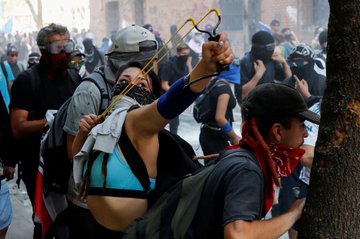Demonstration on the 57th day of the uprising in Chile. An activist who was there on the day reports from Santiago:
“On
December 13th, the 57th day of the uprising, hundreds of thousands were
again in the Plaza de la Dignidad, the place of dignity, as the Plaza
Italia / Baquedano is now called (and this name can already be found on
Google!). The swathes that can be seen in the video in the background
are smoke and tear gas. On the side of the square the “Primera Línea”,
the front row, fights incredibly brave young people, who are the
carabineros of the rest of the demonstrators This fight is incredibly
tough, here is a compilation of street fighting scenes, a short video (also from December 13th): the Primera Línea dances to the Vals del obrero (workers’ waltz ) of the band SKA-P from Madrid, and an article in German the injuries,
Interestingly, there is no “violence discussion” here. On the contrary, these young people are seen as heroes. “Thank you, brave youth!” An older man wrote on his sign. In each speech at the rally, the kids were praised and celebrated with huge applause and chants. There are support brigades that provide the Primera Línea with water and food, and rescue and treat injured people (and are repeatedly attacked themselves). The Alameda cultural center, located in the “Zona 0” conflict zone, is converted into a sanitation station in the evening. The photographers accompanying the Primera Línea are also targeted and their equipment destroyed.
Many of the young people in Primera Línea come from the state homes of the SENAME institution, have had horror through violence and abuse and actually have nothing to lose. However, students (who are at the end of their studies with a huge mountain of debt if they do not come from very wealthy families) also participate here, workers (who do not go on strike but are in the front row after work) We were told that we had kids from better-off families (recognizable by branded clothes and better protective equipment such as gas masks and eye protection) and even from a university professor who throws stones in the evening. “I’d rather die here on the square than on the waiting list,” says a poster. In 2018, 26,000 people died in Chile, while on a waiting list for surgery and medical treatment. Despite everything, the unbelievable hardness of the argument is not a deterrent, but on the contrary is another motive to persevere: so many of us have paid with our lives, lost our eyes, have been arrested, tortured and raped, and we have not yet achieved anything – we cannot give up at all.
Santiago is completely sprayed, some areas look like an Open Air gallery for street art. And an enormous politicization and grassroots organization is underway. Here, too, as in Argentina at that time, assemblies were formed immediately, with a very strong dislike of hierarchies, parties and leaders. Here the demand for and the path to a new constitution is discussed, but also all other areas such as pensions (at the assembly we attended, the largest working group) work, education, health. What do we demand, how do we want to live, what other models are there? Meetings take place not only in the barrios in the center, but also in the Poblaciones, the poorer neighborhoods on the outskirts. Young activists at such a gathering said that waking up Chile changed her life completely. In the past, everyone thought and acted as if they were middle class. The financial problems they had, the rents, the medication and paying for the food at the end of the month would all have been kept to themselves. Now the assembly was talking openly about it, and everyone felt like a working class. The uprising was not just about a better future for her children, but above all revenge for what the dictatorship did to her parents and grandparents. Your generation would have always been waiting for this moment. When asked if this was a revolution, they answered without hesitation together with yes! Despite the hardship, they are totally happy with these developments, two have given up their precarious jobs, to be able to devote full time to the organization. I cannot judge how widespread these individual strikes are. Unfortunately, what is still missing from this revolution are broader strikes. But maybe there is more refusal to work than is shown in the strike statistics. In any case, the economic damage caused by this revolt is considerable. Shops and businesses are closed due to looting and fires. In Santiago, the banks and fine shops are clad with metal plates, but are often still open. In the port city of Valparaiso, banks and supermarkets are closed and the ATMs are no longer working. Those who cannot access neighborhood or other exchange networks have to go shopping in the neighboring seaside resort of Viña del Mar.
At the beginning of the revolt, the “Dignity Square” in Santiago was full of demo performers every evening. In the meantime, the big mobilizations on the square are concentrated on the Fridays, and it is not always as gigantic as on December 13th. But there are demonstrations, performances, protest camps and so on every day. It is suspected that there will be a bit of a summer break over Christmas, but that it will start again in March at the latest, also due to the sanctions that many people have suffered or expected due to their participation in the revolt, such as the loss of jobs and scholarships , Operations at universities usually start again in March. And March 8th is Women’s Day. “(Alix Arnold)

